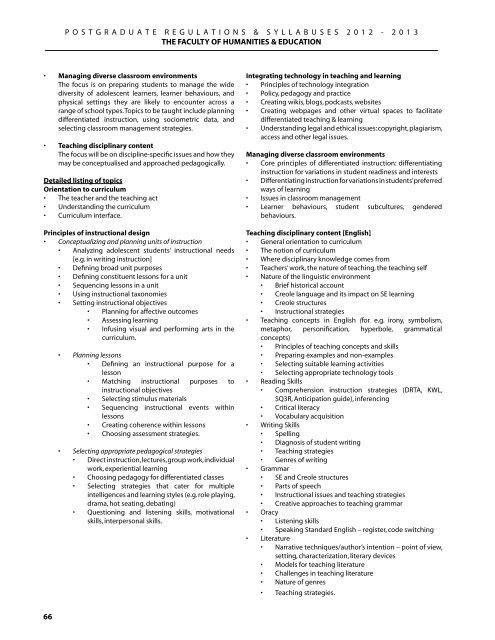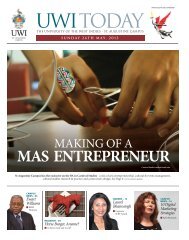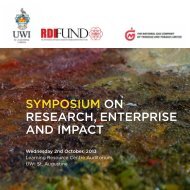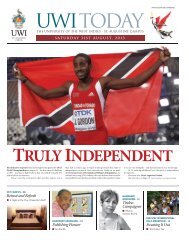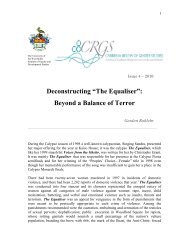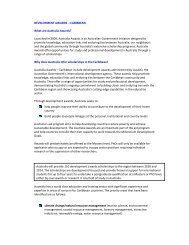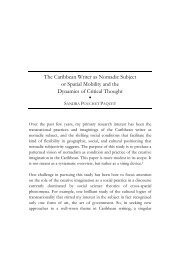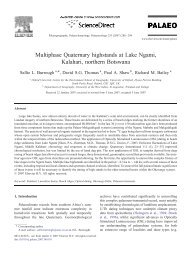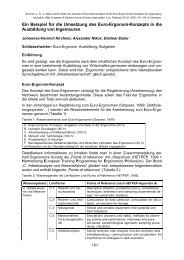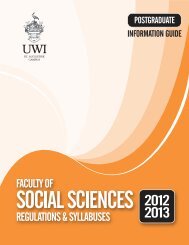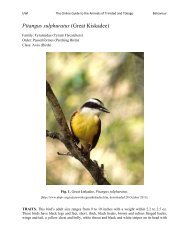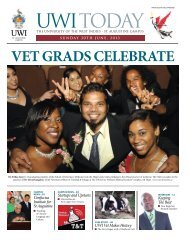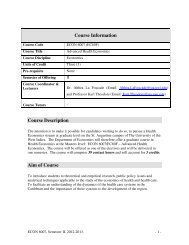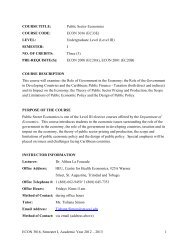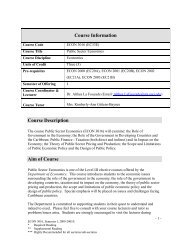Faculty of Humanities and Education (Postgraduate) - The University ...
Faculty of Humanities and Education (Postgraduate) - The University ...
Faculty of Humanities and Education (Postgraduate) - The University ...
You also want an ePaper? Increase the reach of your titles
YUMPU automatically turns print PDFs into web optimized ePapers that Google loves.
66<br />
POSTGRADUATE REGULATIONS & SYLLABUSES 2012 - 2013<br />
THE FACULTY OF HUMANITIES & EDUCATION<br />
• Managing diverse classroom environments<br />
<strong>The</strong> focus is on preparing students to manage the wide<br />
diversity <strong>of</strong> adolescent learners, learner behaviours, <strong>and</strong><br />
physical settings they are likely to encounter across a<br />
range <strong>of</strong> school types. Topics to be taught include planning<br />
differentiated instruction, using sociometric data, <strong>and</strong><br />
selecting classroom management strategies.<br />
• Teaching disciplinary content<br />
<strong>The</strong> focus will be on discipline-specific issues <strong>and</strong> how they<br />
may be conceptualised <strong>and</strong> approached pedagogically.<br />
Detailed listing <strong>of</strong> topics<br />
Orientation to curriculum<br />
• <strong>The</strong> teacher <strong>and</strong> the teaching act<br />
• Underst<strong>and</strong>ing the curriculum<br />
• Curriculum interface.<br />
Principles <strong>of</strong> instructional design<br />
• Conceptualizing <strong>and</strong> planning units <strong>of</strong> instruction<br />
• Analyzing adolescent students’ instructional needs<br />
[e.g. in writing instruction]<br />
• Defining broad unit purposes<br />
• Defining constituent lessons for a unit<br />
• Sequencing lessons in a unit<br />
• Using instructional taxonomies<br />
• Setting instructional objectives<br />
• Planning for affective outcomes<br />
• Assessing learning<br />
• Infusing visual <strong>and</strong> performing arts in the<br />
curriculum.<br />
• Planning lessons<br />
• Defining an instructional purpose for a<br />
lesson<br />
• Matching instructional purposes to<br />
instructional objectives<br />
• Selecting stimulus materials<br />
• Sequencing instructional events within<br />
lessons<br />
• Creating coherence within lessons<br />
• Choosing assessment strategies.<br />
• Selecting appropriate pedagogical strategies<br />
• Direct instruction,lectures,group work,individual<br />
work, experiential learning<br />
• Choosing pedagogy for differentiated classes<br />
• Selecting strategies that cater for multiple<br />
intelligences <strong>and</strong> learning styles (e.g. role playing,<br />
drama, hot seating, debating)<br />
• Questioning <strong>and</strong> listening skills, motivational<br />
skills, interpersonal skills.<br />
Integrating technology in teaching <strong>and</strong> learning<br />
• Principles <strong>of</strong> technology integration<br />
• Policy, pedagogy <strong>and</strong> practice<br />
• Creating wikis, blogs, podcasts, websites<br />
• Creating webpages <strong>and</strong> other virtual spaces to facilitate<br />
differentiated teaching & learning<br />
• Underst<strong>and</strong>ing legal <strong>and</strong> ethical issues:copyright,plagiarism,<br />
access <strong>and</strong> other legal issues.<br />
Managing diverse classroom environments<br />
• Core principles <strong>of</strong> differentiated instruction: differentiating<br />
instruction for variations in student readiness <strong>and</strong> interests<br />
• Differentiatinginstructionforvariationsinstudents’preferred<br />
ways <strong>of</strong> learning<br />
• Issues in classroom management<br />
• Learner behaviours, student subcultures, gendered<br />
behaviours.<br />
Teaching disciplinary content [English]<br />
• General orientation to curriculum<br />
• <strong>The</strong> notion <strong>of</strong> curriculum<br />
• Where disciplinary knowledge comes from<br />
• Teachers’ work, the nature <strong>of</strong> teaching, the teaching self<br />
• Nature <strong>of</strong> the linguistic environment<br />
• Brief historical account<br />
• Creole language <strong>and</strong> its impact on SE learning<br />
• Creole structures<br />
• Instructional strategies<br />
• Teaching concepts in English (for e.g. irony, symbolism,<br />
metaphor,<br />
concepts)<br />
personification, hyperbole, grammatical<br />
• Principles <strong>of</strong> teaching concepts <strong>and</strong> skills<br />
• Preparing examples <strong>and</strong> non-examples<br />
• Selecting suitable learning activities<br />
• Selecting appropriate technology tools<br />
• Reading Skills<br />
• Comprehension instruction strategies (DRTA, KWL,<br />
•<br />
SQ3R, Anticipation guide), inferencing<br />
Critical literacy<br />
• Vocabulary acquisition<br />
• Writing Skills<br />
• Spelling<br />
• Diagnosis <strong>of</strong> student writing<br />
• Teaching strategies<br />
• Genres <strong>of</strong> writing<br />
• Grammar<br />
• SE <strong>and</strong> Creole structures<br />
• Parts <strong>of</strong> speech<br />
• Instructional issues <strong>and</strong> teaching strategies<br />
• Creative approaches to teaching grammar<br />
• Oracy<br />
• Listening skills<br />
• Speaking St<strong>and</strong>ard English – register, code switching<br />
• Literature<br />
• Narrative techniques/author’s intention – point <strong>of</strong> view,<br />
setting, characterization, literary devices<br />
• Models for teaching literature<br />
• Challenges in teaching literature<br />
• Nature <strong>of</strong> genres<br />
• Teaching strategies.


